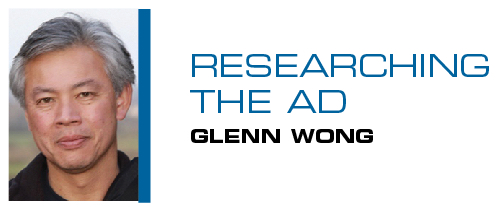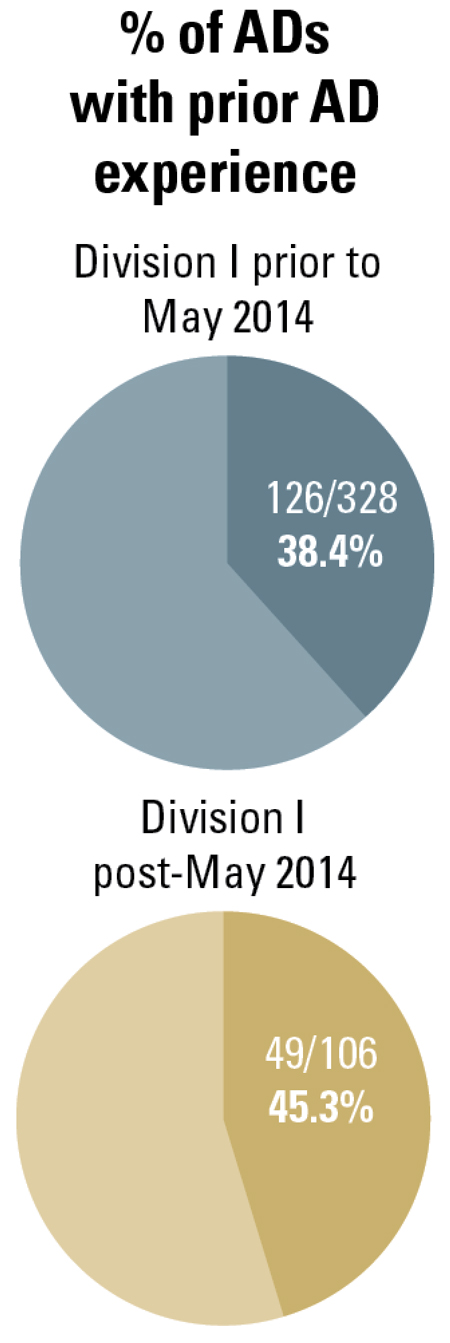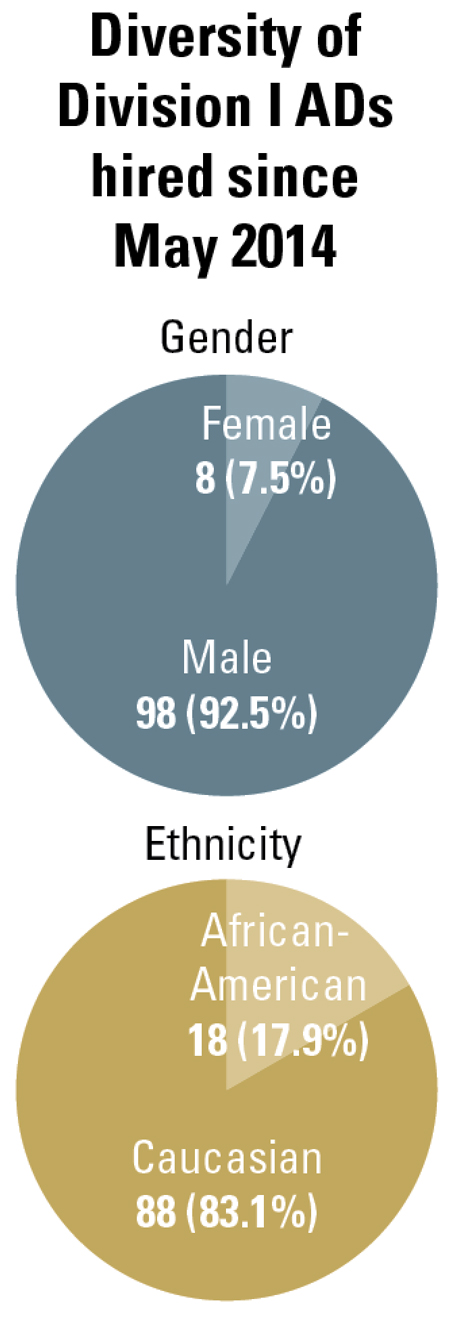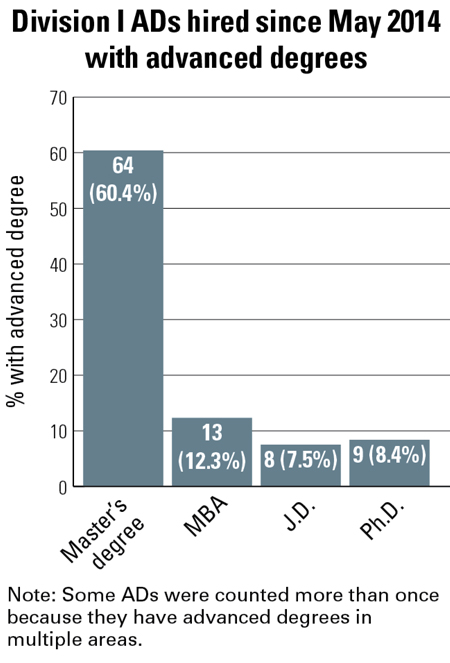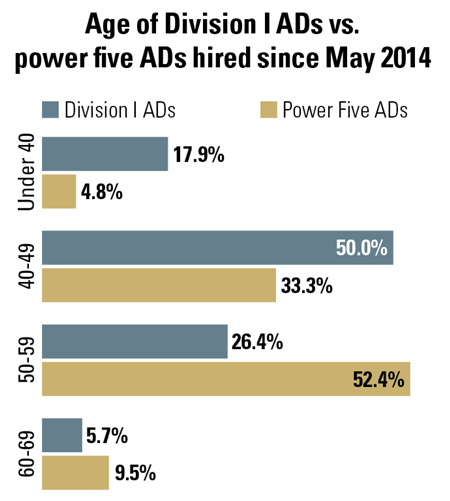$280 million. $252 million. $250 million. $174 million.
Those, respectively, are the values of the apparel contracts signed this year by UCLA, Ohio State, Texas and Michigan, perhaps finally vitiating the notion that upper-echelon collegiate athletics are a purely educational endeavor, and not a revenue-driven business.
As the money flowing into college sports — and the attendant media attention — has increased, the focus on those managing college athletic departments has grown commensurately. In the past 30 months, SportsBusiness Journal has gone in-depth on athletic directors several times, including my article in 2014 discussing the general profile of then-ADs, and also a comprehensive analysis of trends in AD hiring, with a particular focus on the increased turnover rate at the position.
This article offers insights into what is rapidly becoming one of the most influential and powerful management positions on college campuses, a trend that can be attributed in large part to the revenue explosions occurring at the NCAA Division I level. The significantly increased revenues have primarily occurred at institutions in the so-called power five conferences — ACC, SEC, Big Ten, Big 12 and Pac-12, plus Notre Dame — which collectively earned more than $6 billion last year.
And in the 30 months since my June 2014 article was published, the cash inflows have continued their dramatic rise.
In 2014, the first year of the College Football Playoff, conferences and institutions collectively generated more than $500 million from football bowl games alone — between 60 and 70 percent more than was generated during the final year of the Bowl Championship Series. 2014 also marked the launch of the SEC Network, which now adds upward of $100 million to the conference’s coffers annually.
The 2016 calendar year has seen UCLA, Ohio State and Michigan sign apparel contracts that are worth upward of $700 million, the Big Ten agreeing with Fox and ESPN on media rights deals that will generate $2.64 billion for the conference over the next six years, and the NCAA extending its television deal with CBS/Turner through 2032 for its men’s basketball tournament. When the eight-year extension begins in 2024, the NCAA will receive more than $1 billion annually on March Madness alone.
In light of the significant developments that have occurred during the past 30 months and those coming in the future, a close examination of the 106 athletic directors who have been hired in this time frame could reveal whether Division I institutions are responding by selecting a different type of AD. Are there any trends? Are newly hired ADs older or younger than the ADs in 2014? Are there more women and minorities? What is their level of education? How many come from nontraditional employment backgrounds? Are there significant differences between the ADs hired by power five and non-power five schools?
Age and experience
In the June 2014 article, I discussed how the “Theo effect” (whose namesake, current Chicago Cubs president and former Boston Red Sox general manager Theo Epstein, was hired to the former position at age 28), which has spurred the hiring of younger front-office executives in professional team sports, had not yet fully permeated collegiate athletics. Thirty months later, that is still the case. In fact, the new crop of Division I ADs hired since 2014 is older than the average sitting AD was 30 months ago. The average age of the 106 Division I ADs hired in the past two years (at the date of their hire) was 47; the youngest was 28 (Alex Ricker-Gilbert, Jacksonville), and the oldest 68 (Mike Perrin, Texas). This is a slight uptick since 2014, when the average age of a sitting Division I AD at the time of their hire was 45.
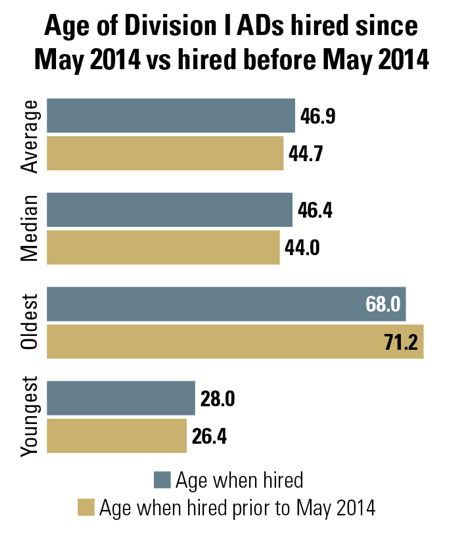 |
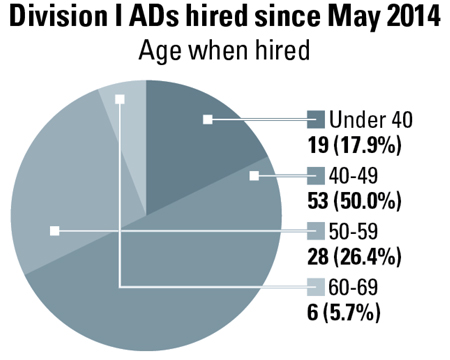 |
Moreover, fewer than 20 percent of the recently hired Division I ADs were under 40 when they accepted their current AD job, compared with nearly 30 percent of sitting ADs in 2014. Among the 106 ADs hired in the past 30 months, almost a third were 50 or older at the date of their hire, a 10 percent jump over Division I ADs in 2014.
A growing necessity for athletic department leaders with previous managerial and/or business experience may be partially responsible for this upward progression in age. Of the 106 Division I ADs hired since May 2014, 46 percent (49 of 106) were previously ADs at other institutions. This represents an increase from 2014, when 38 percent of sitting ADs had other AD experience. In an era when college athletic administrators are
no longer primarily tasked with the success of their sport programs, but also are responsible for revenue generation; public relations; complying with NCAA, state and federal regulations; and dealing with university presidents and boards, hiring ADs with the correct set of skills and competencies may be pushing institutions to look at older, more experienced candidates.
Overall, the hiring patterns for Division I ADs since May 2014 have indicated no “Theo effect” in collegiate athletic administration. In this regard, it is interesting to compare college athletics to professional sports, where there are, with increasing frequency, general managers hired in their late 20s or early 30s (but whose average age at date of hire is 44.9).
Diversity
Gender and racial diversity at the administration level continues to be a challenge in Division I athletics, where 63 percent of athletes are women, black, Hispanic/Latino or Asian, but fewer than 20 percent of Division I ADs are people of color, and fewer than 10 percent are women.
The gender gap is more pronounced among the power five conferences, where only three of 65 (4.6 percent) institutions have female ADs: Washington (Jennifer Cohen), Penn State (Sandy Barbour) and North Carolina State (Deborah Yow). Texas has separate men’s and women’s ADs, the latter of which is female (Chris Plonsky).
“Women are still behind the eight ball when being considered for [AD] jobs,” former Texas women’s AD Donna Lopiano told The New York Times last year. “Because sports are 20 years behind corporate America. It’s the last bastion of the male physical domination in terms of sport itself.”
As a result, Yow said, “I think you’re going to have to wait another century [to see gender parity amongst ADs].”
The hiring trends over the last two years have given little indication of the gender inequity gap closing any time soon: Since 2014, only 7.5 percent (8 of 106) of new AD hires in Division I were women.
The racial data paints a slightly better picture of the NCAA’s efforts toward increasing diversity. In the past 30 months, African-Americans’ share of Division I AD jobs has grown nearly 2 percent, comprising 16.9 percent (18 of 106) of the new AD hires during that time. Still, the racial disparities between student athletes and their coaches and administrators is cause for concern, prompting the NCAA to develop a Presidential Pledge (rolled out in August) that commits signees to establish initiatives for achieving greater diversity in their hiring practices.
Mandating that institutions alter their hiring processes is legally murky, with NCAA President Mark Emmert admitting last year, “there probably isn’t [anything we can do].” State legislatures, however, could play an important role in diversity promotion by requiring a version of the NFL’s Rooney Rule, which requires teams to interview minority candidates for head coaching and certain front-office positions. The Oregon State Legislature has already done so, enacting a law in 2009.
Education
Higher education continues to play a central role in collegiate AD hiring, with all 106 hired since 2014 possessing a
bachelor’s degree. And, mirroring the increasing societal emphasis on post-college education, 77.3 percent (82 of 106) of the new hires have earned advanced degrees: 60 percent hold master’s degrees (64), with the remainder earning an MBA (13), a Ph.D. (9) and a J.D. (8). This percentage is slightly down from 2014, when 78 percent of Division I ADs had graduate degrees. Nevertheless, the growing responsibilities of and pressures on athletic administrators has kept the percentage of ADs with graduate degrees quite high.
Sports administration/management and education are still the most common graduate degrees, comprising more than half of all master’s degrees earned by the recently hired ADs. The past 30 months also have seen slight increases in the number of ADs holding an MBA or J.D., from 19 to 20 percent — perhaps reflecting the increasingly revenue-driven, litigious nature of college athletics.
Nontraditional Hires
Maybe the most interesting aspect of the transformational dynamism in college athletics is the hiring of nontraditional ADs. Nontraditional hires do not have previous collegiate athletic administration experience
but come from management roles outside of college athletics and thus have other skills, competencies and experiences to deal with an increasingly business-oriented and litigious college sports environment.
Overall, eight of the 106 Division I ADs hired in the past 30 months can be termed nontraditional: Scott Corley (Belmont), Kery Davis (Howard), Jim Hackett (Michigan), Steve Lochmueller (Eastern Kentucky), Mollie Marcoux (Princeton), Mike Perrin (Texas), Lynn Swann (USC) and John Wildhack (Syracuse). Not included in these statistics (hired after the data cut-off date) is Mississippi State’s John Cohen, who was the school’s head baseball coach. A key commonality in this group is their alumni status, with seven of the nine receiving their undergraduate degree from the school at which they are currently AD.
While these ADs may not have taken the traditional route to their jobs, there were attractive, unique aspects of each that distinguished them from the pure businessman and added value to their departments. Two others, Rick George at Colorado and Ray Anderson at Arizona State, though not alumni of their current institutions, used their backgrounds in Major League Baseball and the NFL, respectively, to spur fundraising and innovation at their institutions. George oversaw a $100 million fundraising haul, which will fund facility upgrades for nearly every sport Colorado offers. Fellow Pac-12 AD Anderson has reinvigorated his program with an ambitious Athletics Facilities District development and has been instrumental in adding four sport programs to the Sun Devils’ offerings.
Also of note is Wildhack, whose extensive digital media experience at ESPN — and, more importantly, his relationships and contacts within the industry — encourage a positive outlook on his ability to guide Syracuse into a future that may see significant shifts in digital consumption preferences.
What is intriguing about Cohen’s recent hire at Mississippi State is that, until the early 2000s, a common career path to the AD chair was: from player, to coach, to athletic director. While a few vestiges of that era remain — including Barry Alvarez at Wisconsin (hired in 2004) and Ray Tanner at South Carolina (hired in 2012), institutions have increasingly turned away from simply letting coaches ease into retirement in the AD role. However, there are significant advantages coaches have over outside candidates, including their knowledge of and connection with a school’s operation, culture and community (often a key fundraising constituency).
Power Five Focus
Recent conference realignment, shifts in governance structure, and widening revenue disparities have increasingly stratified the NCAA’s Division I, with the power five conferences becoming more and more dissimilar to the remainder of Division I. Power five institutions generated nearly $6 billion in revenue last year, almost tripling that of all other FBS schools combined. The average revenue gap between power five and group of five (American Athletic, Conference USA, Mid-American, Mountain West and Sun Belt conferences) has increased by 50 percent since 2008 and is likely to continue growing. Moreover, the power five has been granted more autonomy within the NCAA’s governance and rule-making processes, allowing these institutions to propose and pass legislation without the support of the entire membership.
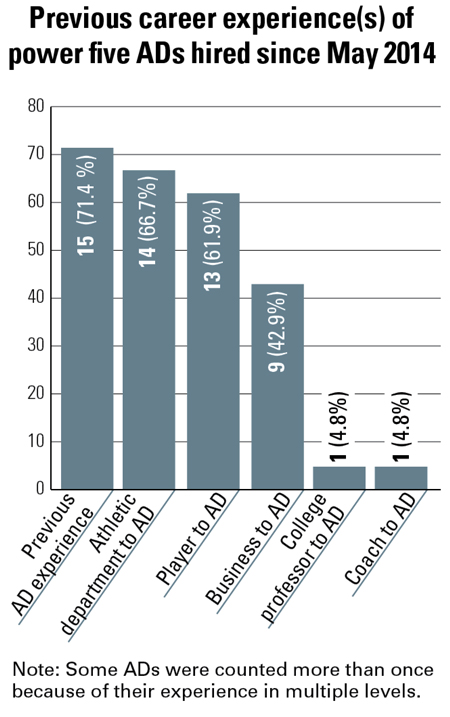 |
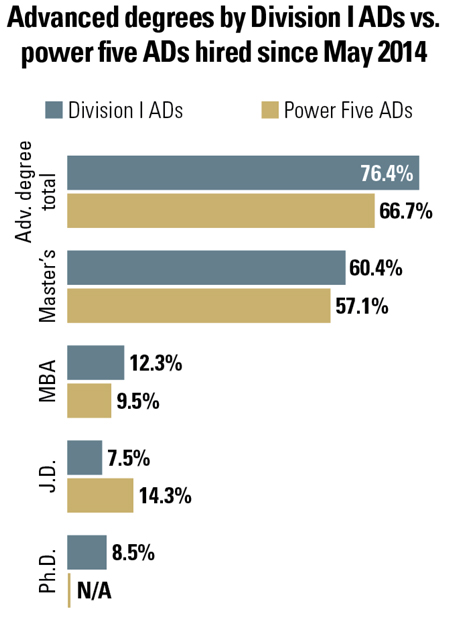 |
Given these significant differences in money and power, are power five institutions hiring a different type of person as AD? The data shows that there is a difference, revealing that the 21 ADs who have been hired at schools in the power five since 2014 are, on the whole, older, less ethnically diverse, more likely to be male, have been a college athlete, have previous AD experience, and hold proportionally fewer advanced degrees than those hired in the remainder of Division I.
Newly hired power five ADs are older than their counterparts in the rest of Division I: Of the 21, only one-third (8 of 21) are under 50 years of age, whereas two-thirds of the non-power five Division I ADs fall into that category.
Half (11 of 21) are between 50 and 59, while just 26 percent of their non-power five peers are similarly aged; 10 percent are 60-69, compared with just about 6 percent of the newly hired, non-power five ADs. Overall, the average age of the new power five ADs (when hired) was 52.5 — five years older than the average non-power five AD.
In addition to being older, newly hired power five ADs were also more likely to have previous AD experience, with
71 percent (15 of 21) holding similar positions prior to their current roles, compared with 40 percent (34 of 85) of non-power five ADs hired since May 2014.
The diversity profile of power five ADs hired since 2014 is also different than their non-power five peers, with African-Americans making up about 10 percent of the hires (compared with 19 percent of non-power five hires) and women accounting for two (9.5 percent) of the 21 new hires (in contrast to 7 percent of non-power five hires).
A higher percentage of power five ADs were former student athletes: 61.9 percent (13 of 21) were former college players, while just 47 percent (40 of 85) of newly hired non-power five ADs had experience as college athletes.
Fourteen of the new power five ADs also came directly from other AD positions, eight of those from another power five institution. Those numbers, coupled with the four nontraditional hires in the power five over the past 30 months, reveal that only three of the 21 were promoted from non-AD positions within collegiate athletics — Patrick Hobbs, Rutgers (dean, Seton Hall Law School), Jennifer Cohen, Washington (senior associate athletic director, Washington) and Shane Lyons, West Virginia (deputy athletic director, Alabama).
And while 76.4 percent of all the Division I ADs hired since 2014 hold advanced degrees, that number drops to 66.7 percent when the new power five ADs are isolated. However, a greater share of new power five hold either MBA or J.D. degrees, again pointing to the increasing desire for business and legal-savvy athletic administrators.
* * *
Following these changes in intercollegiate athletics has been both interesting and informative to those in the industry and for many who aspire to work in college sports. The shifts witnessed over the past few years are likely to merit further analysis in the future.
Glenn M. Wong (glenn.wong@asu.edu) is director of the Sports Law and Business program at the Sandra Day O’Connor College of Law (Arizona State University), where he is also distinguished professor of practice — sports law. Wong served a stint as the University of Massachusetts’ interim AD. He is an attorney and is the immediate past president of the Sports Lawyers Association.


